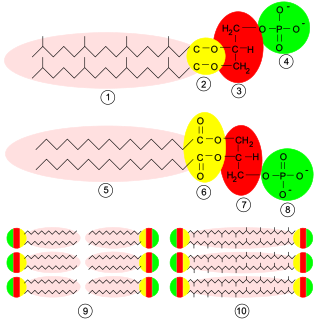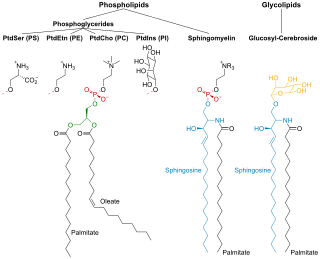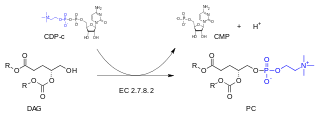
Lipids are a broad group of organic compounds which include fats, waxes, sterols, fat-soluble vitamins, monoglycerides, diglycerides, phospholipids, and others. The functions of lipids include storing energy, signaling, and acting as structural components of cell membranes. Lipids have applications in the cosmetic and food industries, and in nanotechnology.
In biological taxonomy, a domain, also dominion, superkingdom, realm, or empire, is the highest taxonomic rank of all organisms taken together. It was introduced in the three-domain system of taxonomy devised by Carl Woese, Otto Kandler and Mark Wheelis in 1990.

Glycerophospholipids or phosphoglycerides are glycerol-based phospholipids. They are the main component of biological membranes in eukaryotic cells. They are a type of lipid, of which its composition affects membrane structure and properties. Two major classes are known: those for bacteria and eukaryotes and a separate family for archaea.
Platelet-activating factor, also known as PAF, PAF-acether or AGEPC (acetyl-glyceryl-ether-phosphorylcholine), is a potent phospholipid activator and mediator of many leukocyte functions, platelet aggregation and degranulation, inflammation, and anaphylaxis. It is also involved in changes to vascular permeability, the oxidative burst, chemotaxis of leukocytes, as well as augmentation of arachidonic acid metabolism in phagocytes.

Glycerophospholipids of biochemical relevance are divided into three subclasses based on the substitution present at the sn-1 position of the glycerol backbone: acyl, alkyl and alkenyl. Of these, the alkyl and alkenyl moiety in each case form an ether bond, which makes for two types of ether phospholipids, plasmanyl, and plasmenyl. Plasmalogens are plasmenyls with an ester linked lipid at the sn-2 position of the glycerol backbone, chemically designated 1-0(1Z-alkenyl)-2-acyl-glycerophospholipids. The lipid attached to the vinyl ether at sn-1 can be C16:0, C18:0, or C18:1, and the lipid attached to the acyl group at sn-2 can be C22:6 ω-3 or C20:4 ω-6, . Plasmalogens are classified according to their head group, mainly as PC plasmalogens (plasmenylcholines) and PE plasmalogens (plasmenylethalomines) Plasmalogens should not be confused with plasmanyls.
sn-Glycerol 3-phosphate is the organic ion with the formula HOCH2CH(OH)CH2OPO32-. It is one of two stereoisomers of the ester of dibasic phosphoric acid (HOPO32-) and glycerol. It is a component of bacterial and eukaryotic glycerophospholipids. From a historical reason, it is also known as L-glycerol 3-phosphate, D-glycerol 1-phosphate, L-α-glycerophosphoric acid.

Membrane lipids are a group of compounds which form the lipid bilayer of the cell membrane. The three major classes of membrane lipids are phospholipids, glycolipids, and cholesterol. Lipids are amphiphilic: they have one end that is soluble in water ('polar') and an ending that is soluble in fat ('nonpolar'). By forming a double layer with the polar ends pointing outwards and the nonpolar ends pointing inwards membrane lipids can form a 'lipid bilayer' which keeps the watery interior of the cell separate from the watery exterior. The arrangements of lipids and various proteins, acting as receptors and channel pores in the membrane, control the entry and exit of other molecules and ions as part of the cell's metabolism. In order to perform physiological functions, membrane proteins are facilitated to rotate and diffuse laterally in two dimensional expanse of lipid bilayer by the presence of a shell of lipids closely attached to protein surface, called annular lipid shell.
In enzymology, a sn-glycerol-1-phosphate dehydrogenase (EC 1.1.1.261) is an enzyme that catalyzes the chemical reaction
In enzymology, a plasmanylethanolamine desaturase (EC 1.14.99.19) is an enzyme that catalyzes the chemical reaction

In enzymology, a diacylglycerol cholinephosphotransferase is an enzyme that catalyzes the chemical reaction

Caldarchaeol is a membrane-spanning lipid of the glycerol dialkyl glycerol tetraether class. It is found in hyperthermophilic archaea. Membranes made up of caldarchaeol are more stable since the hydrophobic chains are linked together, allowing the microorganisms to withstand high temperatures. It is also known as dibiphytanyldiglycerol tetraether. Two glycerol units are linked together by two strains which consist of two phytanes linked together to form a linear chain of 32 carbon atoms.
Methanobrevibacter smithii is the predominant archaeon in the microbiota of the human gut. M. smithii has a coccobacillus shape. It plays an important role in the efficient digestion of polysaccharides by consuming the end products of bacterial fermentation. Methanobrevibacter smithii is a single-celled microorganism from the Archaea domain. M. smithii is a methanogen, and a hydrogenotroph that recycles the hydrogen by combining it with carbon dioxide to methane. The removal of hydrogen by M. smithii is thought to allow an increase in the extraction of energy from nutrients by shifting bacterial fermentation to more oxidized end products.

Archaea is a domain of single-celled organisms. These microorganisms lack cell nuclei and are therefore prokaryotes. Archaea were initially classified as bacteria, receiving the name archaebacteria, but this term has fallen out of use.
Archaeol is composed of two phytanyl chains linked to the sn-2 and sn-3 positions of glycerol. As its phosphate ester, it is a common component of the membranes of archaea.

sn-Glycerol 1-phosphate is the conjugate base of a phosphoric ester of glycerol. It is a component of ether lipids, which are common for archaea.
This article discusses the Unique properties of hyperthermophilic archaea. Hyperthermophiles are organisms that can live at temperatures ranging between 70 and 125 °C. They have been the subject of intense study since their discovery in 1977 in the Galapagos Rift. It was thought impossible for life to exist at temperatures as great as 100 °C until Pyrolobus fumarii was discovered in 1997. P. fumarii is a unicellular organism from the domain Archaea living in the hydrothermal vents in black smokers along the Mid-Atlantic Ridge. These organisms can live at 106 °C at a pH of 5.5. To get energy from their environment these organisms are facultatively aerobic obligate chemolithoautotrophs, meaning these organisms build biomolecules by harvesting carbon dioxide (CO2) from their environment by using hydrogen (H2) as the primary electron donor and nitrate (NO3−) as the primary electron acceptor. These organisms can even survive the autoclave, which is a machine designed to kill organisms through high temperature and pressure. Because hyperthermophiles live in such hot environments, they must have DNA, membrane, and enzyme modifications that help them withstand intense thermal energy. Such modifications are currently being studied to better understand what allows an organism or protein to survive such harsh conditions. By learning what lets these organisms survive such harsh conditions, researchers can better synthesize molecules for industry that are harder to denature.
Crenarchaeol is a glycerol biphytanes glycerol tetraether (GDGT) biological membrane lipid. Together with archaeol, crenarcheol comprises a major component of archaeal membranes. Archaeal membranes are distinct from those of bacteria and eukaryotes because they contain isoprenoid GDGTs instead of diacyl lipids, which are found in the other domains. It has been proposed that GDGT membrane lipids are an adaptation to the high temperatures present in the environments that are home to extremophile archaea

Hydroxyarchaeol is a core lipid unique to archaea, similar to archaeol, with a hydroxide functional group at the carbon-3 position of one of its ether side chains. It is found exclusively in certain taxa of methanogenic archaea, and is a common biomarker for methanogenesis and methane-oxidation. Isotopic analysis of hydroxyarchaeol can be informative about the environment and substrates for methanogenesis.
Glycerol dialkyl glycerol tetraether lipids (GDGTs) are a class of membrane lipids synthesized by archaea and some bacteria, making them useful biomarkers for these organisms in the geological record. Their presence, structure, and relative abundances in natural materials can be useful as proxies for temperature, terrestrial organic matter input, and soil pH for past periods in Earth history. Some structural forms of GDGT form the basis for the TEX86 paleothermometer. Isoprenoid GDGTs, now known to be synthesized by many archaeal classes, were first discovered in extremophilic archaea cultures. Branched GDGTs, likely synthesized by acidobacteriota, were first discovered in a natural Dutch peat sample in 2000.
Biphytane (or bisphytane) is a C40 isoprenoid produced from glycerol dialkyl glycerol tetraether (GDGT) degradation. As a common lipid membrane component, biphytane is widely used as a biomarker for archaea. In particular, given its association with sites of active anaerobic oxidation of methane (AOM), it is considered a biomarker of methanotrophic archaea. It has been found in both marine and terrestrial environments.











